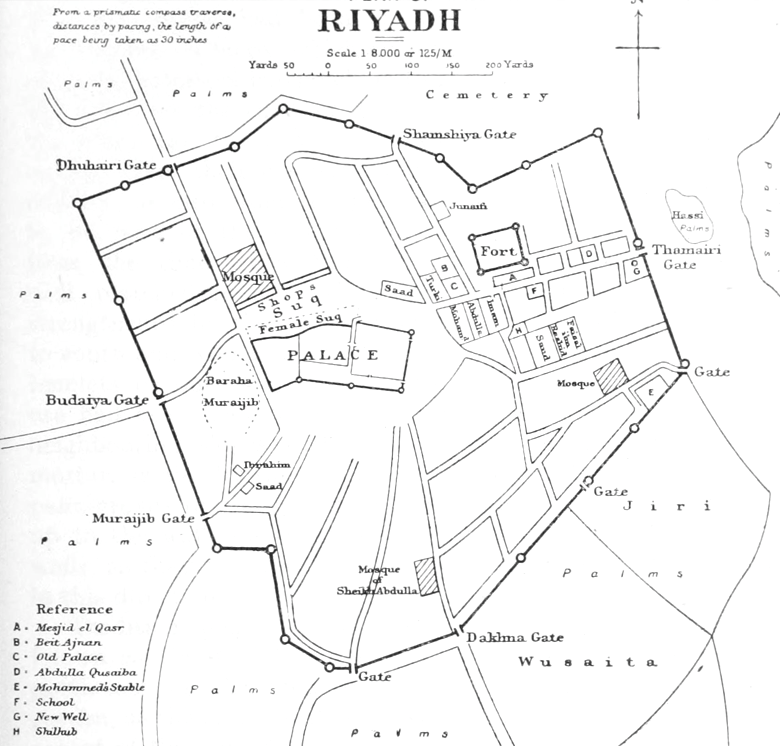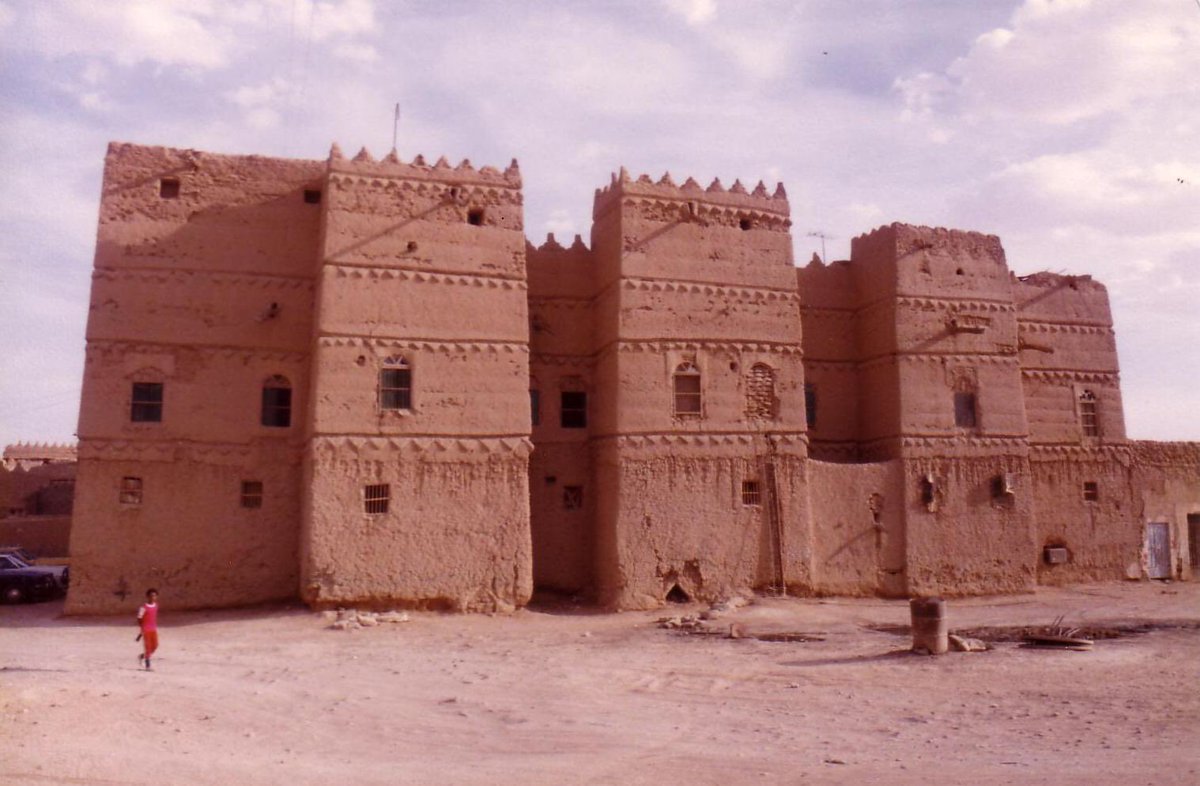|
Quṣūr Al-Fuṭa
Quṣūr al-Fuṭa ( ar, قصور الفوطة, Quṣūr al-Fuṭa) were a group of five palaces in Riyadh, Saudi Arabia. They were built for five sons of King 'Abd al-'Aziz Ibn Saud when they reached the age of marriage. The King ordered the palaces to be built in 1942. The palaces were located in the Al Fouta neighbourhood, a short distance south of Murabba Palace The Murabba Palace (Arabic: Qasr al Murabba; the Square Palace) is one of the historic buildings in Al Murabba, Riyadh, Saudi Arabia. The palace is the first building that was erected outside the walls of the old city. It was named after its squa .... An early photograph by Tommy Walters of ARAMCO was published by Facey in his book ''Riyadh, the Old City''.W. Facey, ''Riyadh, the Old City: From Its Origins until the 1950s'' (London: Immel, 1992), plate 85. References {{Authority control Palaces in Saudi Arabia Demolished buildings and structures in Saudi Arabia ... [...More Info...] [...Related Items...] OR: [Wikipedia] [Google] [Baidu] |
Riyadh
Riyadh (, ar, الرياض, 'ar-Riyāḍ, lit.: 'The Gardens' Najdi pronunciation: ), formerly known as Hajr al-Yamamah, is the capital and largest city of Saudi Arabia. It is also the capital of the Riyadh Province and the centre of the Riyadh Governorate. It is the largest city on the Arabian Peninsula, and is situated in the center of the an-Nafud desert, on the eastern part of the Najd plateau. The city sits at an average of above sea level, and receives around 5 million tourists each year, making it the forty-ninth most visited city in the world and the 6th in the Middle East. Riyadh had a population of 7.6 million people in 2019, making it the most-populous city in Saudi Arabia, 3rd most populous in the Middle East, and 38th most populous in Asia. The first mentioning of the city by the name ''Riyadh'' was in 1590, by an early Arab chronicler. In 1737, Deham Ibn Dawwas, who was from the neighboring Manfuha, settled in and took control of the city. Deham built a ... [...More Info...] [...Related Items...] OR: [Wikipedia] [Google] [Baidu] |
Saudi Arabia
Saudi Arabia, officially the Kingdom of Saudi Arabia (KSA), is a country in Western Asia. It covers the bulk of the Arabian Peninsula, and has a land area of about , making it the fifth-largest country in Asia, the second-largest in the Arab world, and the largest in Western Asia and the Middle East. It is bordered by the Red Sea to the west; Jordan, Iraq, and Kuwait to the north; the Persian Gulf, Qatar and the United Arab Emirates to the east; Oman to the southeast; and Yemen to the south. Bahrain is an island country off the east coast. The Gulf of Aqaba in the northwest separates Saudi Arabia from Egypt. Saudi Arabia is the only country with a coastline along both the Red Sea and the Persian Gulf, and most of its terrain consists of arid desert, lowland, steppe, and mountains. Its capital and largest city is Riyadh. The country is home to Mecca and Medina, the two holiest cities in Islam. Pre-Islamic Arabia, the territory that constitutes modern-day Saudi Ar ... [...More Info...] [...Related Items...] OR: [Wikipedia] [Google] [Baidu] |
Najdi Architecture
Najdi architecture () is a vernacular architecture indigenous to the Najd region of modern-day Saudi Arabia. The style flourished roughly between 13th and 18th centuries and is known for its desert adaptive urban patterns with low-contour earth-structured mudbrick buildings that are characterized by elements such as triangular or rectangular openings (''furjat'') and battlements (''shurfat'') as well as peepholes projecting outward from the main facade (''tarma''). The presence of a central courtyard and open spaces also forms a distinct part of the architectural style. The influence of Najdi style can be felt in neighboring regions, such as Kuwait and inland Qatar. Construction method One of the most common types of construction in the Najd was the use of clay and mudbrick as well as other materials including stones, tamarisk and palm trees. Given the scarce availability of stones and different varieties of trees suitable for construction, the buildings were built with mud or su ... [...More Info...] [...Related Items...] OR: [Wikipedia] [Google] [Baidu] |
Riyadh, Saudi Arabia
Riyadh (, ar, الرياض, 'ar-Riyāḍ, lit.: 'The Gardens' Najdi pronunciation: ), formerly known as Hajr al-Yamamah, is the capital and largest city of Saudi Arabia. It is also the capital of the Riyadh Province and the centre of the Riyadh Governorate. It is the largest city on the Arabian Peninsula, and is situated in the center of the an-Nafud desert, on the eastern part of the Najd plateau. The city sits at an average of above sea level, and receives around 5 million tourists each year, making it the forty-ninth most visited city in the world and the 6th in the Middle East. Riyadh had a population of 7.6 million people in 2019, making it the most-populous city in Saudi Arabia, 3rd most populous in the Middle East, and 38th most populous in Asia. The first mentioning of the city by the name ''Riyadh'' was in 1590, by an early Arab chronicler. In 1737, Deham Ibn Dawwas, who was from the neighboring Manfuha, settled in and took control of the city. Deham built a ... [...More Info...] [...Related Items...] OR: [Wikipedia] [Google] [Baidu] |
Ibn Saud
Abdulaziz bin Abdul Rahman Al Saud ( ar, عبد العزيز بن عبد الرحمن آل سعود, ʿAbd al ʿAzīz bin ʿAbd ar Raḥman Āl Suʿūd; 15 January 1875Ibn Saud's birth year has been a source of debate. It is generally accepted as 1875, although a few sources give it as 1880. According to British author Robert Lacey's book ''The Kingdom'', a leading Saudi historian found records that show Ibn Saud in 1891 greeting an important tribal delegation. The historian reasoned that a 10 or 11-year-old child (as given by the 1880 birth date) would have been too young to be allowed to greet such a delegation, while an adolescent of 15 or 16 (as given by the 1875 date) would likely have been allowed. When Lacey interviewed one of Ibn Saud's sons prior to writing the book, the son recalled that his father often laughed at records showing his birth date to be 1880. Ibn Saud's response to such records was reportedly that "I swallowed four years of my life." p. 561" – 9 Novembe ... [...More Info...] [...Related Items...] OR: [Wikipedia] [Google] [Baidu] |
Al Fouta
Al-Fouta (), alternatively transliterated as al-Futah, is a neighborhood in central Riyadh, Saudi Arabia, located south of al-Murabba and north of al-Dirah in the sub-municipality of al-Malaz. It emerged in the 1940s following the construction of the Red Palace for then Saudi crown prince Saud bin Abdulaziz. It popularly hosts the Riyadh Water Tower, one of the notable landmarks in the city as well as the rest of the southern portion of the King Abdulaziz Historical Center The King Abdulaziz Historical Center (KAHC) () is a translocational compound that includes prominent cultural and heritage landmarks in the al-Murabba and al-Futah neighborhoods of Riyadh, Saudi Arabia, encompassing the al-Murabba Palace, the N ..., including the eponymous al-Fouta Park. As the neighborhood is bounded by al-Batʼha Street to the east, its eastern strip partially forms part of the al-Batʼha commercial area. The neighborhood is unofficially divided into two sections, Fouta East () and ... [...More Info...] [...Related Items...] OR: [Wikipedia] [Google] [Baidu] |
Murabba Palace
The Murabba Palace (Arabic: Qasr al Murabba; the Square Palace) is one of the historic buildings in Al Murabba, Riyadh, Saudi Arabia. The palace is the first building that was erected outside the walls of the old city. It was named after its square with the form of . It is one of the museums in the city. History The palace was built by King Abdulaziz outside Riyadh, being the first major expansion of the city in the twentieth century. Construction was started in 1936 and partly finalized in 1938. It was fully completed in 1945. The construction was supervised by builder Ibn Qabba, but the King also personally involved in the construction process. The palace was intended to be a family residence and court for the king. With the construction of the palace three novel technologies were introduced to the Saudi society: the use of the automobiles as means of transportation, electricity by means of generators and water closets with drainage systems. In order to connect the palace with ... [...More Info...] [...Related Items...] OR: [Wikipedia] [Google] [Baidu] |
ARAMCO
Saudi Aramco ( ar, أرامكو السعودية '), officially the Saudi Arabian Oil Company (formerly Arabian-American Oil Company) or simply Aramco, is a Saudi Arabian public petroleum and natural gas company based in Dhahran. , it is one of the largest companies in the world by revenue. Saudi Aramco has both the world's second-largest proven crude oil reserves, at more than , and largest daily oil production of all oil-producing companies. It is the single greatest contributor to global carbon emissions of any company in the world since 1965. On 11 May 2022, Saudi Aramco became the largest (most valuable) company in the world by market cap, surpassing Apple Inc. Saudi Aramco operates the world's largest single hydrocarbon network, the Master Gas System. In 2013 crude oil production total was , and it manages over one hundred oil and gas fields in Saudi Arabia, including 288.4 trillion standard cubic feet (scf) of natural gas reserves. Saudi Aramco operates the Ghawar Field ... [...More Info...] [...Related Items...] OR: [Wikipedia] [Google] [Baidu] |
Palaces In Saudi Arabia
A palace is a grand residence, especially a royal residence, or the home of a head of state or some other high-ranking dignitary, such as a bishop or archbishop. The word is derived from the Latin name palātium, for Palatine Hill in Rome which housed the Imperial residences. Most European languages have a version of the term (''palais'', ''palazzo'', ''palacio'', etc.), and many use it for a wider range of buildings than English. In many parts of Europe, the equivalent term is also applied to large private houses in cities, especially of the aristocracy; often the term for a large country house is different. Many historic palaces are now put to other uses such as parliaments, museums, hotels, or office buildings. The word is also sometimes used to describe a lavishly ornate building used for public entertainment or exhibitions such as a movie palace. A palace is distinguished from a castle while the latter clearly is fortified or has the style of a fortification, whereas a ... [...More Info...] [...Related Items...] OR: [Wikipedia] [Google] [Baidu] |






